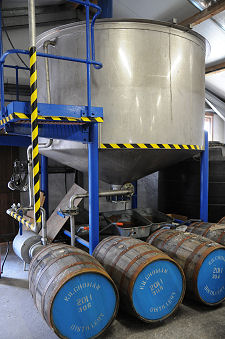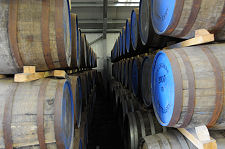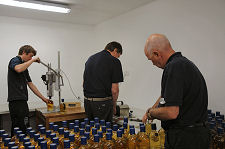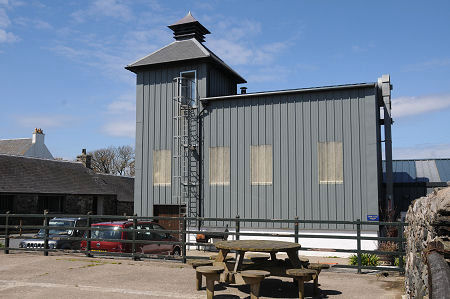 Kilchoman Distillery |
Kilchoman Distillery is the new kid on the block in terms of Islay distilleries. It was launched in June 2005 during the Islay Whisky Festival, and has since been adding its own rather unique style to Islay's already very diverse range of working distilleries. It was said to have been the first new distillery to be established on the island for 124 years. The distillery is found in the west of the island and can be reached via the B8010 from the north-west corner of Loch Indaal, then a minor single track road close to the southern shore of Loch Gorm, and the final third of a mile along the stone surfaced access track to Rockside Farm itself.
Kilchoman Distillery is a return to an earlier age, in which it was the norm for distilleries to be small scale establishments which developed around existing farms. Distilling originally developed on Islay because of the ready availability of the main raw materials, barley and soft water, and because there was a plentiful supply of fuel to dry the malted barley and fire the stills in the form of peat. The first distillers on the island produced their spirit informally and outside the law.
Over time the illegal distillers were displaced by farm distilleries, and over more time, some of those grew far beyond their origins to become the distilleries you seen on Islay today, while many others simply closed. Rockside Farm, home to Kilchoman Distillery, remains a working farm. It grows barley, and also has a riding stables: and as a result you can think of the distillery as a modern expression of a very old tradition. The farm also has a popular visitor centre, offering a large shop selling a wide range of items including, of course, the product of the distillery; and a cafe positioned to give excellent views north over Loch Gorm and this little known part of Islay.
The name "Kilchoman" is drawn from the long established but now tiny settlement half a mile to the south-west, which is home to a ruined church, two stone crosses and a military cemetery. Incidentally, the name is pronounced as if the "c" didn't exist.
Its farming heritage, and the determination of those who established the distillery, means that Kilchoman Distillery has a claim to fame that is absolutely unique among Scottish distilleries. It is the only distillery in which absolutely every element of the process, from growing at least some of the barley to bottling the Scotch whisky, takes place on the premises.
Each year around 100 tonnes of barley is grown at Rockside Farm, and this is malted on the distillery's own malt floor. The malted barley then goes into Kilchoman's own kiln, which stops the germination of the barley at the optimum point, dries the grain, and uses a peat furnace to give it a peaty smokiness. These days, only six Scottish distilleries (including two others in Islay, Bowmore and Laphroaig) have their own traditional maltings, so it is very welcome that one of the youngest should be among them.
Most distilleries buy in their malted barley from large industrial maltings such as the one at Port Ellen on Islay, and like the other distilleries on Islay with their own maltings, Kilchoman supplements what it malts itself with malted barley from the Port Ellen maltings. At Kilchoman this means that about a third of the malted barley is grown and malted on site, with about two thirds being bought in.
Malted barley from the two sources is kept completely separate, which allows Kilchoman to produce a proportion of whisky that really has been grown, malted, brewed, distilled, matured and bottled in the same place, which in the modern era is a remarkable achievement and a unique selling point.
Apart from the very modern malting floor and kiln, visitors to Kilchoman will find that most of the elements in the production process are familiar from visits to other distilleries. Though on a rather smaller scale: Kilchoman is one of Scotland's smallest distilleries and has an annual production of about 90,000 litres of alcohol. You can find out more about Making Malt Whisky from our series of feature pages showing the stages in the process.
Most of the main parts in the process are housed in a very traditional stone building not far from the kiln and pagoda. Here you find the, to use a cliche, "small but perfectly formed" pair of stills. These look much like stills you find in many other distilleries, and come complete with the "blue for spirit and red for wash" colour coding of the pipes and other accessories associated with each still: but they are about as small as is legally permitted in Scotland. There is a minimum legal size for stills as a leftover of legislation originally intended to prevent illegal distillation by individuals using portable stills and condensers. At Kilchoman an average distillation takes around 100 hours. Nearby are the nice copper topped mash tun and the four stainless steel washbacks.
The annual production of 90,000 litres is enough to fill around 630 bourbon barrels and 40 sherry butts, and these make their way into Kilchoman's bonded warehouse. Here you begin to appreciate some of the issues facing anyone setting up a completely new distillery from scratch. By law, the spirit emerging from distillery stills cannot be called Scotch whisky until it has matured for a minimum of three years. So if you do start a new distillery, you cannot hope to sell any whisky for at least thee years: which implies a long term commitment and a large investment.
Kilchoman's first single malt was released in 2009, and there have been subsequent releases. The aim, however, is to hold back a proportion of the output to allow 10 and 12 year old single malts to be released in due course. The first "100% Islay" single malt, produced entirely at the distillery using barley grown on the farm, was released in June 2011.
 The Still Room |

|
|
|
Visitor InformationView Location on MapRockside Farm, Bruichladdich, Isle of Islay, PA49 7UT. Tel: 01496 850011. Grid Ref: NR 223 637 www.kilchomandistillery.com Opening Hours Tours & Admission What3Words Location: ///tram.tasty.stapled |
 Peat Furnace Under
Kiln Peat Furnace Under
Kiln |
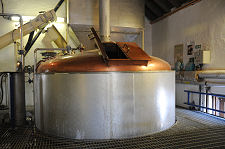 The Mash Tun The Mash Tun |
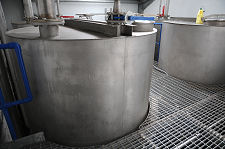 The Washbacks The Washbacks |
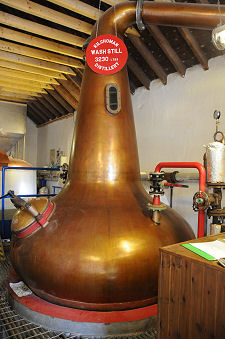 The Wash Still The Wash Still |
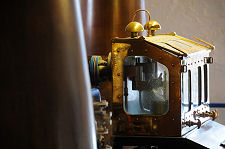 The Spirit Safe The Spirit Safe |
 Spirit Emerging in the Spirit Safe |

